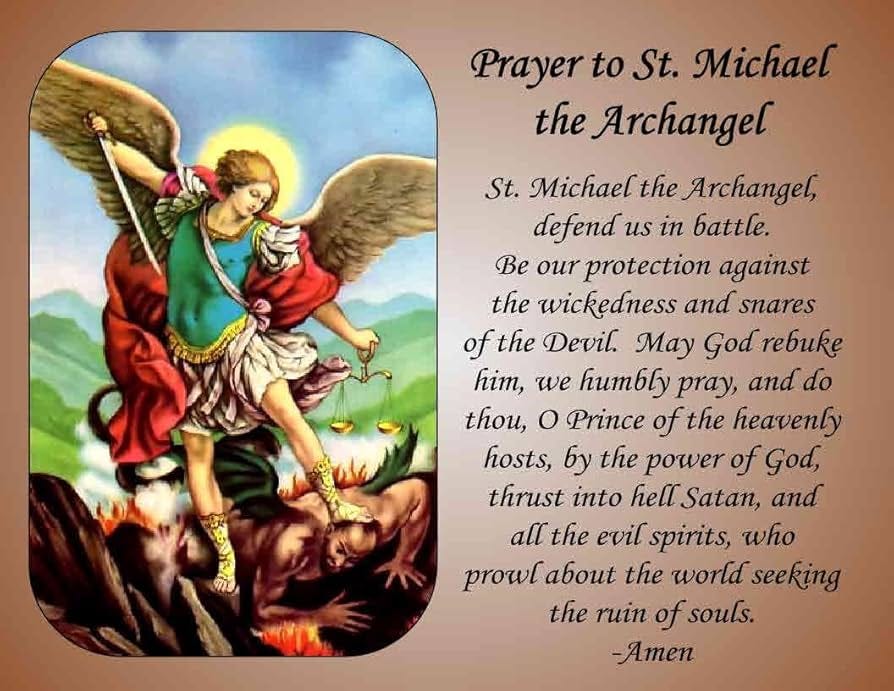Despite only a few biblical references to him, Michael—the leader of the angelic army—is arguably the most popular of all archangels. His importance in Judaism, Catholicism, and Islam cannot be understated.
In Catholicism, Michael plays a critical role. According to the Book of Revelation, he led the angelic host during the Great War in Heaven, casting Lucifer and his rebellious angels from God's kingdom. Saints such as St. Basil and Thomas Aquinas have called him a "prince" among angels.
The St. Michael the ArchAngel is one of my personal favorite prayers during troubled times, and in general. It is one of only three archangels named in the Bible—alongside Raphael (Book of Tobit) and Gabriel (Gospel of Luke). The Book of Enoch, though not canonical in Catholic tradition, adds four others: Uriel, Saraqael, Raguel, and Remiel.
Some believe Michael is the only true archangel, as The Epistle of Jude is the only biblical text that explicitly refers to him as such. In the Book of Daniel, he's called “one of the chief princes,” suggesting other high-ranking angels exist, though none are named as archangel.
Michael appears four times in the Bible:
Twice in Daniel
Once in Jude
Once in Revelation
In Daniel 10:10–14, he is “one of the chief princes” revealed through a vision. In Daniel 12:1–3, he stands with the people during the end times. Jude 9 describes him “contending with the devil” over Moses’ body—this passage includes Michael’s only recorded words: “The Lord rebuke you!” Finally, Revelation 12:7 depicts Michael leading angels in battle against the dragon (Satan), ultimately casting him and his followers into hell.
Over time, Michael became the patron and protector of the Church. He is believed to guard the souls of the dying, ensure their safe passage, and fight Satan’s forces until the end of days. Catholic traditions even suggest he may have guarded Eden’s gates, delivered the Ten Commandments, destroyed Sennacherib’s army, and blocked Balaam’s path.
Michael is regularly invoked in exorcism rites and prayers like the Confiteor from the Tridentine Mass. Catholic teaching outlines four main roles:
Guardian of the Church
Archnemesis of Satan
Archangel of Death
Defender of God’s people (both Jews and Christians)
Art and depictions show him as an armored warrior with a sword and shield inscribed with “Quis ut Deus?” (“Who is like God?”). He’s sometimes shown weighing souls during judgment or standing over a defeated dragon—Satan.
Michael also plays a role in Islam, where he is known as Mika’il. He’s regarded as the Angel of Mercy, associated with divine providence, rain, and food security. The Quran names only two archangels: Mika’il and Jibril (Gabriel), both seen as protectors and intercessors.
According to Islamic tradition, the Prophet Muhammad met both Mika’il and Jibril. Mika’il is portrayed as solemn, reportedly having “not laughed since the creation of Hellfire.”
Michael’s devotion dates back to 300–400 CE. The Western Church began observing Michaelmas in the 5th century, aligning it with harvest time and the autumn equinox. Traditions varied—from fasting to renting land with goose payments—and Michael’s feast day became a time of spiritual and societal renewal.
Theological interpretations vary. Jehovah’s Witnesses believe Michael is Christ in his pre-human and post-resurrection form, citing passages like Jude 9 and 1 Thessalonians 4:16. In contrast, Latter-day Saints believe Michael was the mortal Adam before becoming the archangel.
Regardless of doctrine, Michael remains one of the most iconic figures in religious history—a warrior, protector, and eternal adversary of evil.
Here is the prayer of the St. Michael:
Thanks for reading! Consider sharing and/or commenting for more.
Yelena














Share this post